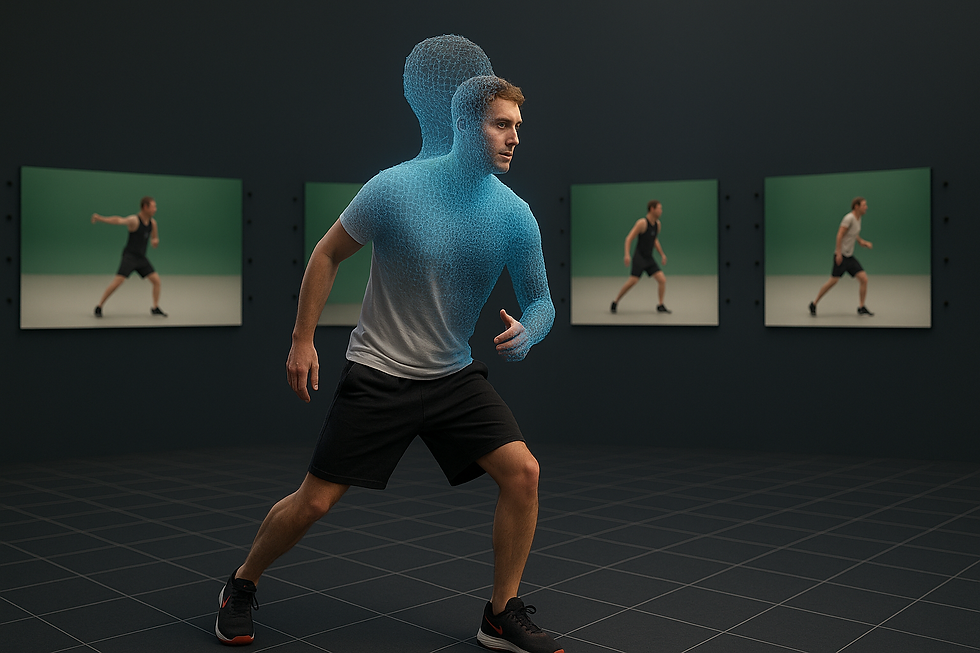What Is Volumetric Video? And Why Should Event Creatives Care?
- Aug 18
- 4 min read

Volumetric video is one of those terms people nod along to, until someone asks them to explain it. It sounds technical, futuristic, maybe even slightly irrelevant.
But behind the buzzword is a genuinely useful piece of technology that's already transforming how performances, broadcasts and brand experiences are being made. And if you're in the business of designing unforgettable moments, it's worth knowing what this tech can (and can't) do.
What is Volumetric Video?
In short: it's 3D video capture.
Unlike traditional video, which flattens everything into a single perspective, volumetric video records real people, objects or performances in full three dimensional space. This means during playback viewers can move around the subject, seeing them from different angles, in virtual environments, AR layers, or immersive installations.
The process usually involves dozens of cameras capturing the subject from all sides at once. Special software then stitches this footage into a 3D mesh with textures. The result? A digital 3D version of a real world moment.
It's not CGI or animation. It's a real human, recorded volumetrically, and placed inside a digital world.
How Does It Work? (For the Curious)
To capture a volumetric scene, a studio will:
Set up a 360 degree rig of high resolution cameras
Light the space evenly to reduce shadows and inconsistencies
Record simultaneous footage of the subject moving, speaking or performing
Feed the footage into software that creates a 3D model with photorealistic textures
The end result is a playable 3D asset that behaves like a video, but can be experienced like a sculpture.
Emerging techniques like Gaussian splatting are changing how this process works. Instead of building detailed polygon meshes, these newer methods use overlapping translucent ‘splats’ to create softer, more fluid reconstructions, making the tech more accessible and visually flexible.
Where Is It Being Used Right Now?
Volumetric video isn't just lab fodder. It's in:
Music & Live Performance: Coldplay and BTS used volumetric video in a performance of "My Universe" on The Voice, with BTS appearing as holograms rendered in Unreal Engine via a 108 camera setup. (TalentRecap)
Sport Broadcasts & Replays: Intel’s "True View" tech was used at Super Bowl LIII, capturing 3D replays with 38 ultra HD cameras to allow fans to rotate and explore plays from any angle. (Intel)
Fashion & Retail: Japanese brand ANAYI created an online experience allowing users to rotate models in 3D via AR using volumetric video. Similar tech was used in metaverse fashion runways by Dimension Studio and Wild Capture. (8thWall, Vogue Business)
Training & Enterprise: Enterprises are using volumetric video to capture staff performing complex tasks or walkthroughs to create interactive, spatial training modules. (Forbes)
Virtual Production: Studios are integrating live volumetric assets into LED stages and game engines like Unreal to enable dynamic set extensions and reactive environments.
While its use in advocacy and documentary is less mainstream, the potential is high: immersive, emotionally resonant storytelling via AR scenes featuring real people is a natural fit for the medium.
Why Should Event Teams Care?
Because it opens up new formats for storytelling, especially in hybrid, spatial or digitally augmented environments.
Volumetric video lets you:
Drop real performers into AR scenes
Create explorable archives of installations or speeches
Deliver content that audiences can walk around, not just watch
Make remote audiences feel like they're in the room (or vice versa)
For producers juggling creative vision and logistics, volumetric video offers a bridge between theatre and simulation. It lets you pre-visualise complex moments, rehearse with digital doubles, or showcase behind the scenes content in a radically new format.
What Are the Watchouts?
This isn't plug and play. Volumetric capture:
Requires a lot of cameras and compute power
Still struggles with hair, fabric, and real time streaming
Often needs custom apps or platforms for viewing
It's also a newer medium. That means workflows are still being defined, file sizes can balloon quickly, and integration into live shows takes testing.
But like any powerful tool, the limitations are balanced by possibility. Teams willing to experiment early can shape how this medium is used in the future.
Future Potential: What Comes Next?
As volumetric video tech matures, we’ll see:
Easier mobile capture (imagine volumetric selfies on your phone)
Richer browser playback, no VR headset needed
Tighter integration with AI tools to automate clean up and rigging
Higher fidelity storytelling in heritage, education, and large scale events
Imagine capturing an Olympic torch handover in volumetric video, then making it replayable at scale in museums, schools, or public spaces.
Final Thought:
Volumetric video isn't a magic bullet. But it's a seriously useful tool for event creatives and producers who want to experiment with space, presence and emotion in more ambitious ways.
The tech might be evolving, but the potential for unforgettable moments is already here.
Further Reading & References:
Coldplay & BTS volumetric performance: TalentRecap
Intel True View at Super Bowl LIII: Intel
ANAYI fashion AR experience: 8thWall
Metaverse fashion shows with Dimension Studio: Vogue Business
Enterprise training via volumetric video: Forbes




Comments